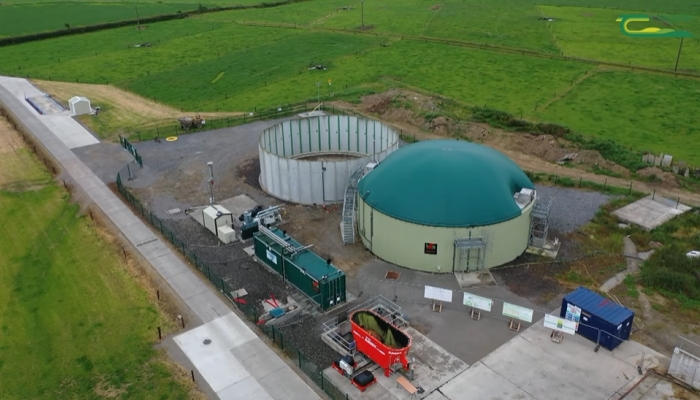16 December 2023
Anaerobic digestion: What does it offer farmers?

Providing feedstock to anaerobic digestion plants could present opportunities to farm businesses, writes Maurice Deasy, Teagasc Athenry, and Ciara Beausang, Teagasc Grange. The anaerobic digestion plant at Teagasc Grange will help identify the best options.
What is anaerobic digestion?
Anaerobic digestion (AD) is the breakdown of organic material, such as food waste, slurry and silage, in the absence of oxygen, to form biogas and digestate. This biogas is renewable energy, containing mostly methane (CH4) and carbon dioxide (CO2).
Many of the AD plants in operation here use the biogas in an engine to create heat and electricity. This is known as ‘combined heat and power’ or CHP. Biogas can also be upgraded to pure methane or ‘biomethane’ by removing the carbon dioxide. It can then be used as a direct replacement for natural gas.
Biomethane can also be used in the transport sector as Compressed Natural Gas (CNG). There are already trucks running on CNG and recently a biomethane tractor has made an appearance at shows here.
The carbon dioxide can also be captured for use in the food and beverage industry. The digestate (the material left over once the gas has been produced) is a potential fertiliser that contains all the nutrients that were in the feedstocks going into the digester. Typically the dry matter content of digestate is around 6-8% which is similar to animal slurry. However an important difference is that fertiliser value has been increased, particularly the plant available nitrogen content.
The circular Bioeconomy
Animal slurries and silages are used to create energy, and the digestate is reused to create fertiliser for crop growth, resulting in a circular system where nutrients are continuously recycled.
The Irish Government set a sectoral emissions reduction target of 25% for agriculture by 2030 relative to 2018 levels. The government has also set a target of producing 5.7TWh of biomethane by 2030, which is the equivalent of 10% of our current demand for natural gas. This demonstrates the role AD can play in reducing emissions and creating a circular bioeconomy.
If animal slurries are digested anaerobically, the methane is captured rather than being lost to the atmosphere, thereby reducing emissions from agriculture. The increased nitrogen fertiliser replacement value of the digestate will reduce the requirement for inorganic nitrogen fertiliser, providing further emission savings in agriculture.
Are all organic materials suitable?
The Renewable Energy Directive (RED II) defines targets for sustainability of biomethane from AD plants and supply chains. Animal slurries are given a manure credit for the capture of methane that would otherwise have been lost to the atmosphere.
The challenge with animal slurries is that they have a low yield of energy per tonne of material. Food wastes and organic residues can have higher energy yields and ensure the recycling of nutrients into organic fertilisers for application to farmland.
Silage and crops have higher energy yields than animal slurries. However, the energy used in their production must be accounted for. In particular if chemical nitrogen is used to grow the crop for an AD plant, or if there is land use change, it will reduce the environmental sustainability of the biomethane.
Teagasc is investigating the use of red-clover silage and multispecies swards as feedstocks for AD plants. Ireland is unique across Europe in being able to produce high yields from grass silage, and the use of legumes such as clover would reduce or eliminate the requirement for nitrogen fertiliser.
The Teagasc Grange AD plant
Teagasc Grange is the site of an AD plant which is undergoing the final stages of commissioning. The digester consists of a 1,600m3 concrete tank. The tank wall is fitted with external insulation protected by steel cladding. The tank is covered by a gas tight membrane on top.
Anaerobic means without oxygen, and digestion means the breakdown of organic matter by different groups of microorganisms, which is what happens in the main digester vessel. The Teagasc AD plant will co-digest grass silage and cattle slurry.
The feedstocks are pre-mixed before being fed into the digester. The digester will be heated to 38°C. The daily feedstock mix will be approximately 10 tonnes of grass silage at 25% dry matter (DM) and 10 tonnes of slurry at 8% DM. The quantities of each will depend on silage quality, primarily dry matter digestibility.
This AD plant will require silage from approximately 70ha and the winter slurry from 1,000 cattle. The biogas that is produced will be upgraded to biomethane by removing the carbon dioxide.
The plant will produce around 1,100m3 of biomethane per day. This is the equivalent of 1,000 litres of diesel. The biomethane will be transported by road tanker to a central injection point where the biomethane is injected into the gas grid.
Research at Teagasc Grange is exploring alternative combinations of feedstock in AD with the overall aim being to optimise biogas production. Co-digestion of manure with grass silage provides many advantages in optimising the AD process.
The main advantages are an increase in the biogas yield and process stability, increasing the biogas plant’s economic viability. Mathematical modelling of the AD process is a powerful tool allowing changes in operating conditions to be simulated and determining which variables are most influencing the biogas and methane yields.
For instance, the mix ratio between the feedstocks (grass silage: cattle slurry ratio), the hydraulic retention time (HRT) and the reactor temperature are some of the variables that affect biogas production.
Looking to Europe
To reach the target of 5.7TWh of biomethane by 2030, over 150 large scale AD plants will have to be constructed. These plants will have an annual capacity of 40GWh or greater. For comparison, the Teagasc Grange AD plant will have an annual capacity of 3GWh. The likely model for agricultural AD in Ireland will be centralised plants, with several farms in the catchment area supplying the feedstocks.
Other countries in Europe have developed successful AD industries. In 2022, 39% of Denmark’s gas consumption came from biomethane. The Danish Parliament has agreed to increase biomethane production to substitute 100% of the Danish gas demand before 2030. Most of Denmark’s biogas is produced from manure. There are around 80 AD plants in Northern Ireland, which predominantly use agricultural feedstocks, including silage. In both Denmark and Northern Ireland, biogas has been promoted through public subsidies.
This article first appeared in the November/December edition of Today’s Farm. Access the full publication here.
